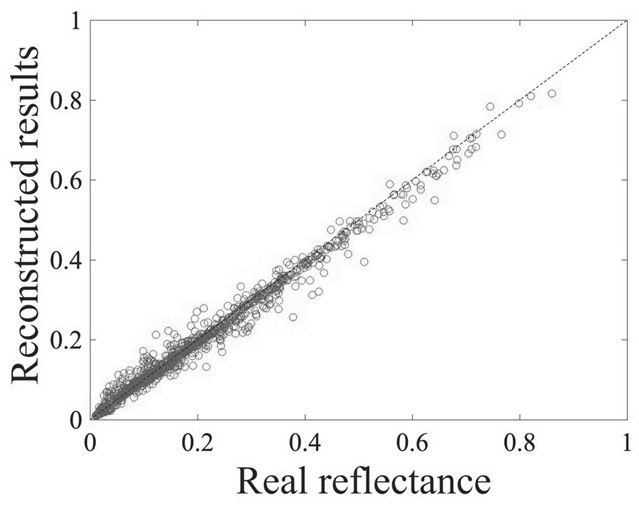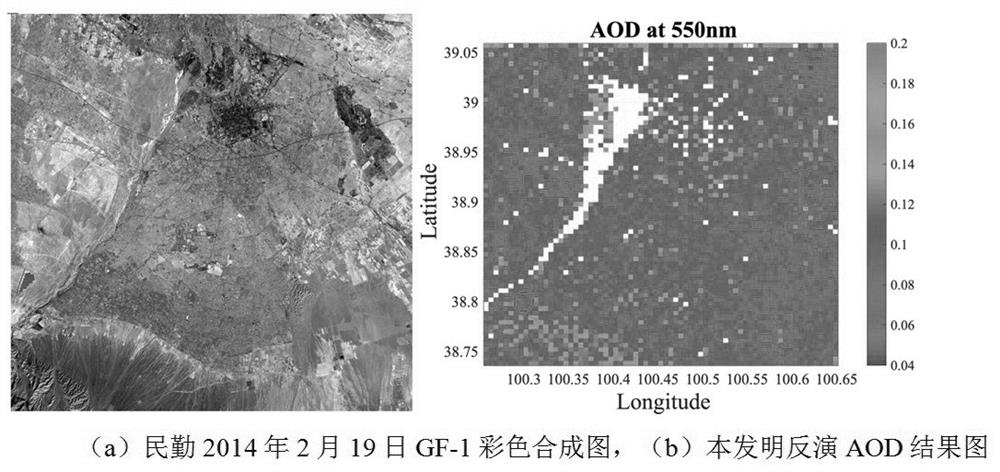A joint inversion method for aerosol and surface parameters
A joint inversion, aerosol technology, applied in the field of air pollution control, can solve problems such as incompatibility, inaccurate image registration, inappropriate surface
- Summary
- Abstract
- Description
- Claims
- Application Information
AI Technical Summary
Problems solved by technology
Method used
Image
Examples
Embodiment 1
[0078] Example 1: Accurate inversion of high spatial resolution AOD in the case of complex surface and low aerosol
[0079] figure 2 (a) is the color composite map of GF-1 in Minqin, Gansu Province on February 19, 2014, and (b) is the spatial distribution map of the aerosol optical depth (AOD) result obtained by the inversion of the present invention with a spatial resolution of 1 km. The surface type of this study area is very complex, including various surfaces such as deserts, mountains, hills, and plains (cities, vegetation, bare soil, small water bodies), as can be seen from the AOD result map of the inversion of the present invention. On the basis of part of the ultra-bright surface, the optical spatial distribution of aerosols is relatively smooth, which is in good agreement with the 550nm AOD results (AOD=0.12) of the earth observation results, and the inversion accuracy is still the same in complex bright surfaces and low aerosol conditions. Can meet ±(20%*AOD (地基实...
Embodiment 2
[0080]Example 2: Accurate inversion of high spatial resolution AOD in the case of complex surface light pollution
[0081] image 3 (a) is a color composite map of GF-1 on May 6, 2015 in Xi'an, Shaanxi, and (b) is an AOD spatial distribution map with a spatial resolution of 1km obtained by inversion of the present invention. From the GF-1 satellite color composite map, it can be seen that the research area includes complex surface types such as cities, rivers and mountains, and the spatial distribution of AOD retrieved by the present invention clearly shows the diffusion from cities with dense human life to suburbs with less activities Decreasing trend, the AOD spatial resolution of 1km has obvious advantages in high spatial resolution compared with the 10km spatial resolution of the two MODIS algorithms. At the same time, in the case of light pollution in the urban area, the inversion can be compared with the ground-based observation results (AOD=0.44), and the inversion err...
Embodiment 3
[0082] Example 3: Accurate inversion of high spatial resolution AOD in the case of complex surface light pollution
[0083] Figure 4 (a) is a color composite map of GF-1 on December 30, 2014 in Xi'an, Shaanxi, and (b) is an AOD spatial distribution map with a spatial resolution of 1 km obtained by inversion of the present invention. It can be seen from the inverted AOD spatial distribution map of the present invention that the distribution of aerosol optical thickness also tends to decrease from urban to suburban areas, and the inverted AOD has the advantage of high spatial resolution. In the case of light pollution in the urban area, the inversion can be consistent with the ground-based observation (AOD=0.39), and the inversion error is less than (20%*AOD (地基实测) +0.05) accuracy.
PUM
| Property | Measurement | Unit |
|---|---|---|
| wavelength | aaaaa | aaaaa |
Abstract
Description
Claims
Application Information
 Login to View More
Login to View More - R&D
- Intellectual Property
- Life Sciences
- Materials
- Tech Scout
- Unparalleled Data Quality
- Higher Quality Content
- 60% Fewer Hallucinations
Browse by: Latest US Patents, China's latest patents, Technical Efficacy Thesaurus, Application Domain, Technology Topic, Popular Technical Reports.
© 2025 PatSnap. All rights reserved.Legal|Privacy policy|Modern Slavery Act Transparency Statement|Sitemap|About US| Contact US: help@patsnap.com



